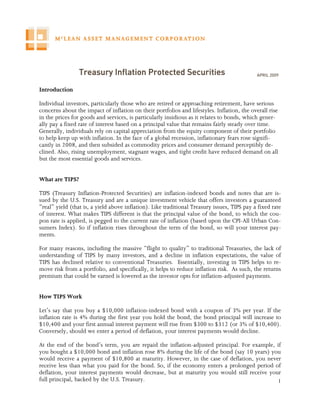
TIPS
- 1. Treasury Inflation Protected Securities APRIL 2009 Introduction Individual investors, particularly those who are retired or approaching retirement, have serious concerns about the impact of inflation on their portfolios and lifestyles. Inflation, the overall rise in the prices for goods and services, is particularly insidious as it relates to bonds, which gener- ally pay a fixed rate of interest based on a principal value that remains fairly steady over time. Generally, individuals rely on capital appreciation from the equity component of their portfolio to help keep up with inflation. In the face of a global recession, inflationary fears rose signifi- cantly in 2008, and then subsided as commodity prices and consumer demand perceptibly de- clined. Also, rising unemployment, stagnant wages, and tight credit have reduced demand on all but the most essential goods and services. What are TIPS? TIPS (Treasury Inflation-Protected Securities) are inflation-indexed bonds and notes that are is- sued by the U.S. Treasury and are a unique investment vehicle that offers investors a guaranteed “real” yield (that is, a yield above inflation). Like traditional Treasury issues, TIPS pay a fixed rate of interest. What makes TIPS different is that the principal value of the bond, to which the cou- pon rate is applied, is pegged to the current rate of inflation (based upon the CPI-All Urban Con- sumers Index). So if inflation rises throughout the term of the bond, so will your interest pay- ments. For many reasons, including the massive “flight to quality” to traditional Treasuries, the lack of understanding of TIPS by many investors, and a decline in inflation expectations, the value of TIPS has declined relative to conventional Treasuries. Essentially, investing in TIPS helps to re- move risk from a portfolio, and specifically, it helps to reduce inflation risk. As such, the returns premium that could be earned is lowered as the investor opts for inflation-adjusted payments. How TIPS Work Let’s say that you buy a $10,000 inflation-indexed bond with a coupon of 3% per year. If the inflation rate is 4% during the first year you hold the bond, the bond principal will increase to $10,400 and your first annual interest payment will rise from $300 to $312 (or 3% of $10,400). Conversely, should we enter a period of deflation, your interest payments would decline. At the end of the bond’s term, you are repaid the inflation-adjusted principal. For example, if you bought a $10,000 bond and inflation rose 8% during the life of the bond (say 10 years) you would receive a payment of $10,800 at maturity. However, in the case of deflation, you never receive less than what you paid for the bond. So, if the economy enters a prolonged period of deflation, your interest payments would decrease, but at maturity you would still receive your full principal, backed by the U.S. Treasury. 1
- 2. The Benefit of TIPS in a Portfolio Hedging against inflation — The U.S. Treasury specifically designed TIPS to help protect inves- tors from the negative impact of inflation. The explicit inflation hedge offered by TIPS is impor- tant because inflation can rise suddenly and unexpectedly. An unexpected surge in inflation poses a significant threat to portfolio returns – particularly from bonds. Lower nominal returns and ris- ing inflation can potentially result in significantly lower real returns. TIPS, with their explicit link to changes in inflation, provide predictable real returns even during inflationary times. TIPS vs. Other Treasuries — There are three factors that impact the yield volatility of a conven- tional treasury bond: changes in the real yield; changes in inflation; and changing compensation for the uncertainty of future inflation. TIPS eliminate the uncertainty of future inflation since their price adjusts. As such, TIPS have been persistently less volatile than conventional Treasury bonds of similar maturity, yet one might say that TIPS are as volatile as inflationary pressure. TIPS correlations are attractive — TIPS, because of their link to inflation, can also enhance the diversification of an overall portfolio. Diversification does not ensure against loss, but can smooth a portfolio’s performance, therefore enhancing the quality of portfolio earnings. Remem- ber, bonds typically react negatively to increasing inflation. TIPS are basically free from this con- cern and, therefore, do not move in lockstep with conventional bonds. TIPS enhances the diversi- fication of a broader portfolio, thereby reducing the portfolio’s volatility, and potentially improv- ing overall returns. 2
- 3. Summary Recall that return premiums are earned by taking on risk. Inflation is simply a risk factor that is being removed from the equation. As such, the returns are less likely to be significant when compared to equity. Taking on less risk means limiting potential returns. For TIPS investors, this is often a very acceptable goal; moreover, having a government guarantee makes these bonds even more attractive. While having principal protection and a hedge against inflation are both notable reasons to purchase TIPS, there is also the diversification benefit. Through most of 2008, TIPS performed well as inflationary fears were high and commodity prices soared. At the end of 2008, TIPS began to drag and commodity prices began to fall dramatically. In the first quarter of 2009, TIPS was again a top performer. TIPS are not inherently less volatile, yet the addition of TIPS in a portfolio can help to reduce overall volatility. The lack of inflation risk in TIPS essentially removes a portion of that risk factor from the portfolio. Thus, overall uncertainty can be lowered, and protection of capital may be better facilitated. McLean Asset Management Corporation 6845 Elm Street Suite 305 McLean, VA 22101 P: (703) 827-0636 F: (703) 556-8628 www.mcleanam.com www.investmentsignal.net 3